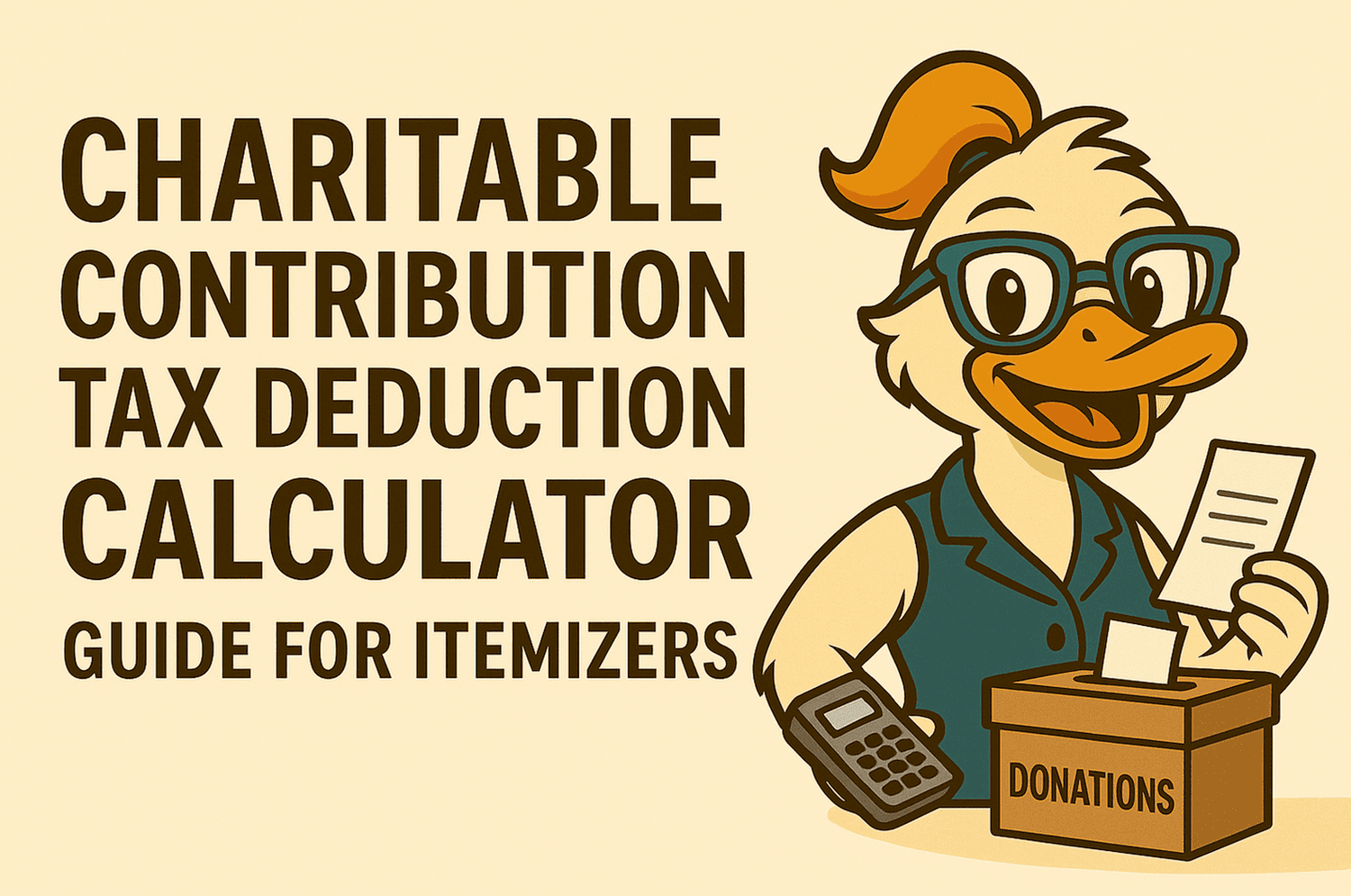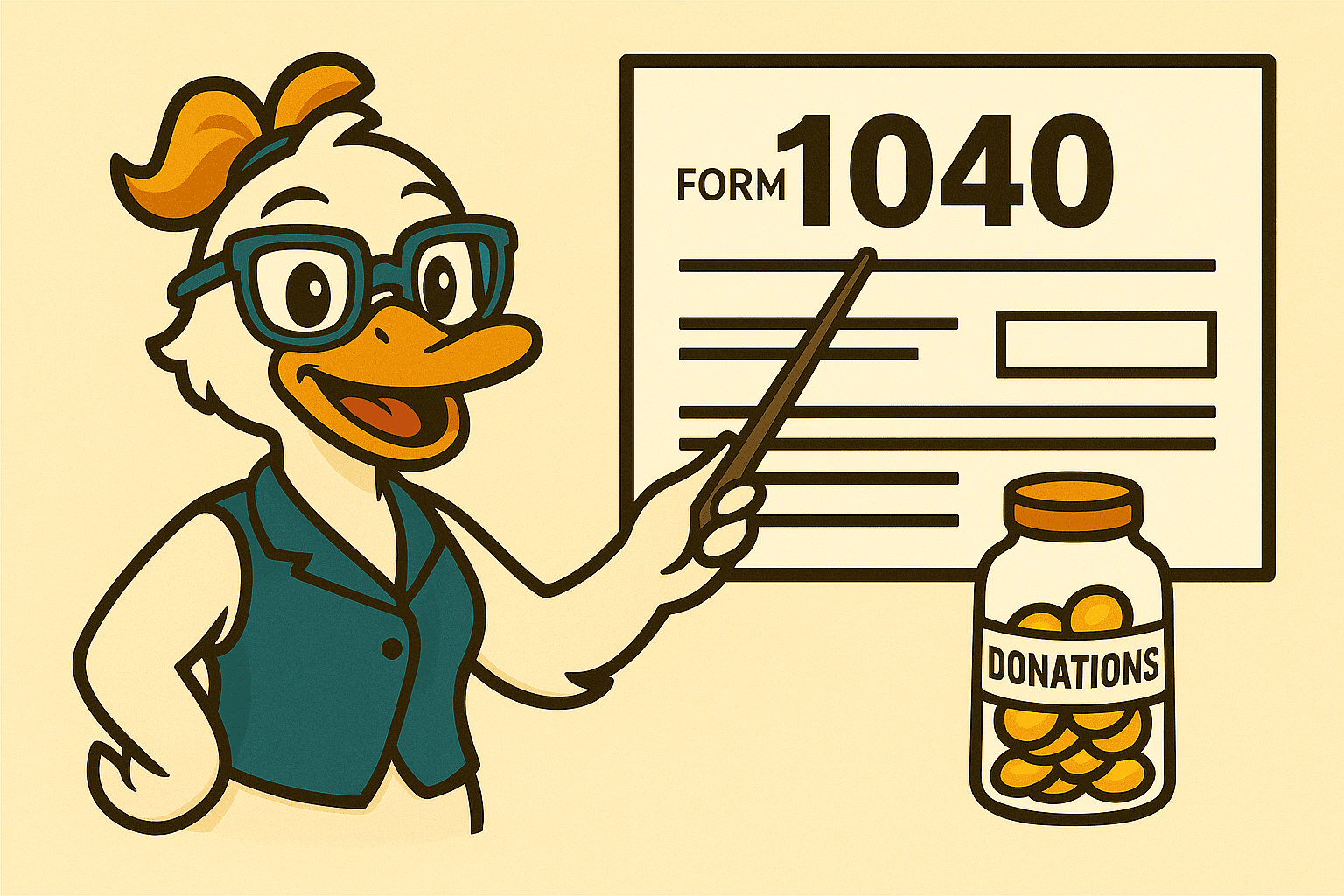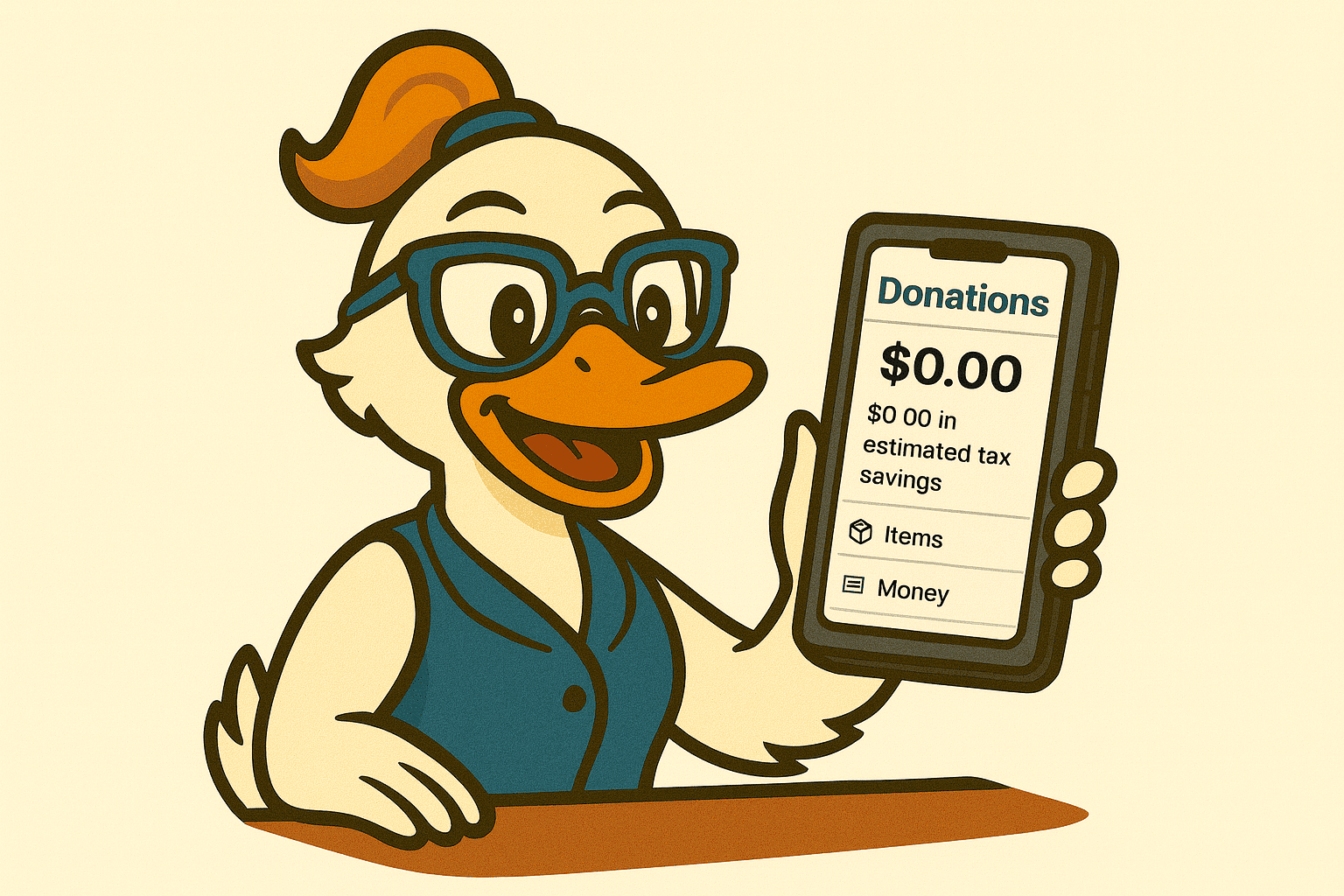The Ultimate Guide: Charitable Contribution Tax Deduction Calculator for 2025

If you’re wondering how your generosity affects your taxes, you’re not alone. Every year, millions of Americans make charitable donations and then ask a simple question with a surprisingly layered answer: How much will charitable donations reduce taxes?
Charitable contributions can be powerful tools for lowering taxable income—but only if you understand a handful of core ideas:
- How deductions work (itemizing versus the standard deduction),
- How to value what you give (cash versus property),
- How to document your gifts (receipts and acknowledgments), and
- How annual limits work (Adjusted Gross Income, or AGI, ceilings and carryovers).
This guide walks through those concepts in plain English, with examples for real‑world situations, and includes “For Financial Wizards” callouts referencing IRS authority so more experienced readers can go straight to the primary sources (IRS Topic No. 506; Publications 526, 561, and 1771).
You’ll also find a practical “charitable contribution tax deduction calculator” section that explains how to estimate your savings using your own numbers, and worked examples that blend cash and property donations. Throughout, we stick to IRS rules only—no speculation, no third‑party interpretations.
What is a charitable donation?

A charitable donation is a voluntary gift of money or property made to a qualified organization for public benefit, without receiving goods or services in return (or, if you do receive something, you deduct only the portion that exceeds the fair market value of what you received). For tax purposes, a contribution is deductible when it’s made to organizations recognized by the IRS—think public charities, religious organizations, certain educational institutions, and governments—subject to documentation, valuation, and annual limit rules.
Below are four common types of donations recognized in everyday filing and in IRS guidance. Each type has its own documentation and valuation considerations:
1) Cash donations
“Cash” includes checks, credit or debit card payments, gifts made via an online processor, electronic funds transfers, and even gift cards redeemable for cash. To deduct cash gifts, you need a bank record (such as a canceled check or account statement) or a written acknowledgment from the charity showing the organization name, contribution date, and amount. For single contributions of $250 or more, a contemporaneous written acknowledgment from the charity is required that states whether you received any goods or services in return.
Example (cash): You give $500 via a charity’s website. You receive an automatically generated email that lists the charity’s name, the date, the amount, and a statement that no goods or services were provided. Keep that email with your records—it satisfies the written acknowledgment requirement for a $250+ gift.
2) Noncash item (property) donations
“Property” donations include clothing, furniture, appliances, books, tools, and other tangible goods. For household goods and clothing, the IRS requires items to be in good used condition or better. Your deduction is based on Fair Market Value (FMV)—essentially, what a willing buyer would pay a willing seller, neither being compelled to act, and both having reasonable knowledge of the relevant facts. For noncash contributions over $500 (aggregate for the year), attach Form 8283 (Section A). For a single item or group of similar items over $5,000, you generally need a qualified appraisal and Form 8283 (Section B) signed by the appraiser and the donee.
Example (noncash items): You donate a gently used sofa, two end tables, and a set of bookshelves to a qualifying thrift store. You receive a receipt describing the items. You later determine FMV by looking at comparable thrift store resale prices for similar quality items, documenting how you arrived at your numbers. Your total value is $620; you attach Form 8283 Section A because your noncash total exceeds $500 for the year.
3) Stock and other securities donations
Donating appreciated securities (e.g., individual stocks, ETFs, or mutual funds) can be tax‑efficient: you generally deduct the FMV of the shares on the date of the gift and you typically avoid capital gains tax on the appreciation. For publicly traded securities, FMV is usually the average of the high and low selling prices on the date of the gift (or other acceptable published market price methods). As with other noncash gifts, use Form 8283 when required, and coordinate the transfer through your broker and the charity to ensure the donation date is clearly established.
Example (stock): You bought 50 shares for $20 each years ago. They’re worth $60 each today. Donating the shares directly to a qualified public charity allows you to deduct $3,000 (50 × $60) and sidestep capital gains on the $2,000 of appreciation.
4) Charitable mileage and out‑of‑pocket volunteer expenses
When you use your personal vehicle while providing services for a qualified organization, you can deduct charitable mileage at the IRS statutory rate of 14 cents per mile, plus parking fees and tolls. Similarly, unreimbursed out‑of‑pocket expenses incurred while performing bona fide services for a charity may be deductible, provided you keep records and receipts. You cannot deduct the value of your time.
Example (mileage): You drive 12 miles round‑trip each week to deliver meals for a qualified nonprofit. After 40 trips, that’s 480 miles × $0.14 = $67.20 of deductible charitable mileage, plus any parking and tolls paid while volunteering.
🧙 For Financial Wizards (authority & references)
- Publication 1771 (substantiation): rules for bank records, contemporaneous acknowledgments, and quid pro quo disclosures (for gifts where you receive something in return).
- Publication 561 (valuation): how FMV works for various kinds of property and when an appraisal is required.
- Publication 526 and Topic No. 506 (deductibility and limits): which gifts qualify, AGI limits, carryovers, and special cases.
Start Tracking Your Donations Now
Enter those valuable donations year-round and export an IRS-friendly report when you’re ready to file, just like ItsDeductible. Only $29.99/year
How much will charitable donations reduce taxes?

First, donations reduce taxable income, not the tax bill directly. The savings are roughly your marginal tax rate multiplied by your deductible amount. If you’re in a 22% bracket and you can deduct $1,000, your federal tax savings are approximately $220. If you take the standard deduction rather than itemizing, you generally cannot deduct charitable gifts at all (with the past exception of temporary rules that no longer apply).
Two big drivers explain why two people giving the same amount can see very different results:
1) Itemizing vs. standard deduction. If you don’t itemize, your donation typically won’t reduce your taxes.
2) Bracket and AGI limits. The value of a deduction rises with your marginal rate; at the same time, charitable deductions are capped as a percentage of AGI depending on the type of gift and the donee.
Illustration (step‑by‑step):
- Taylor gives $2,500 to qualified charities during the year.
- Taylor adds up all itemized deductions (mortgage interest, state and local taxes subject to annual limits, medical deductions that exceed the threshold, plus charitable gifts).
- If Taylor’s total itemized deductions exceed the standard deduction for Taylor’s filing status, Taylor itemizes and deducts the full $2,500 (subject to AGI limits).
- If not, Taylor takes the standard deduction and the $2,500 does not reduce federal taxable income.
Is it worth it to claim charitable donations on taxes?
It can be—but only if you itemize deductions. Charitable donations are among the more controllable itemized deductions; you choose the timing and amount of giving. If your itemized deductions are near the standard deduction threshold, “bunching” gifts (grouping two years’ donations into one tax year) can push you over the threshold in one year, letting you itemize in that year and then take the standard deduction the next.
Example (bunching):
Amber typically gives $2,000 each year. Instead, Amber gives $4,000 this year and nothing next year. This year, the extra $2,000 helps push total itemized deductions above the standard deduction, producing real tax savings in the itemizing year.
🧙 For Financial Wizards
- Bunching works best when combined with other itemized deductions (e.g., mortgage interest) to clear the standard‑deduction hurdle. See Topic No. 506 and Publication 526 for deductibility rules.
What if my donation is worth over $5000?
For noncash property worth over $5,000 (a single item or a group of similar items), you generally need a qualified appraisal prepared and signed by a qualified appraiser. You also complete Form 8283, Section B, which the appraiser and the charity sign. Without the appraisal, the IRS can disallow the deduction even if the charity received your gift.
Example (artwork):
You donate a painting to a museum. Your appraiser determines FMV is $9,800 and provides a qualified appraisal. You and the donee complete Form 8283 Section B and keep the appraisal with your records. If requested, higher‑value art may require additional documentation.
🧙 For Financial Wizards
- See Publication 561 for appraisal standards and Form 8283 instructions for thresholds, appraiser qualifications, and documentation details.
How much of a tax break do I get for charitable donations?
The type of gift and type of organization determine your AGI limit for the year:
- Cash gifts to most public charities: generally deductible up to 60% of AGI.
- Property gifts (capital gain property to public charities): commonly 30% of AGI (with special rules for basis‑only deductions to certain organizations).
- Private foundations: typically lower limits (e.g., 20% for certain gifts).
If your total contributions exceed the applicable limit, you can usually carry forward the excess and deduct it in each of the next five years (still subject to the annual limits).
Example (limits and carryover):
Jordan’s AGI is $200,000. Jordan makes $120,000 of cash gifts to public charities this year. Jordan may deduct up to $120,000 or the 60% of AGI cap—i.e., up to $120,000 if within the limit, with any excess carried over up to five years. If Jordan’s total cash gifts were $140,000, the current‑year deduction would be limited to $120,000 and the remaining $20,000 generally could be carried forward.
🧙 For Financial Wizards
- See Publication 526 and Topic No. 506 for AGI‑limit tables and carryover ordering rules. Publication 526 also details how different property types (ordinary income property vs. capital gain property) and donee types (public charity vs. private foundation) change the applicable limit and whether you deduct FMV or basis.
Why don’t my charitable donations reduce my taxes?
Four common reasons:
1) You took the standard deduction. Charitable deductions usually require itemizing on Schedule A.
2) The organization wasn’t qualified. Gifts to individuals, political organizations, or many crowdfunding campaigns are not deductible.
3) No contemporaneous written acknowledgment for $250+ gifts. Without it, the deduction can be disallowed.
4) AGI limits or property rules applied. High givers or donors of appreciated property may hit a cap or a rule that limits the current‑year deduction.
🧙 For Financial Wizards
- See Publication 1771 for acknowledgment requirements and Publication 526 for rules on qualified organizations, AGI limits, and carryovers.
Start Tracking Your Donations Now
Enter those valuable donations year-round and export an IRS-friendly report when you’re ready to file, just like ItsDeductible. Only $29.99/year
What happened to the $600 charitable deduction?

For a brief period, taxpayers who did not itemize could still deduct a limited amount of cash gifts as an “above‑the‑line” deduction—up to $300 per person ($600 for joint filers) in 2020–2021. That temporary rule expired. Under current rules, charitable gifts are generally deducted only when you itemize.
Example (then vs. now):
In the temporary period, a couple taking the standard deduction could still claim an extra $600 for qualifying cash donations. Today, that extra above‑the‑line write‑off is not available. To deduct donations, you must itemize.
Why did charitable deductions go away?
They didn’t. The long‑standing itemized deduction for charitable contributions remains. Only the temporary above‑the‑line feature for non‑itemizers ended. Charitable deductions continue under Schedule A with the usual documentation and limit rules.
Can you deduct $600 charitable contributions?
Yes if you itemize and otherwise meet the requirements (qualified charity, proper records, and within AGI limits). The automatic $600 above‑the‑line deduction for non‑itemizers is no longer in effect.
Why didn’t my charitable donations reduce my taxes?
If you took the standard deduction, your donations likely didn’t change your taxable income. To see a benefit, your itemized deductions must exceed the standard deduction for your filing status.
Are charitable donations no longer tax deductible?
They’re still deductible for itemizers who give to qualified organizations and maintain proper records. The rules for acknowledgments and disclosures (especially for gifts of $250 or more or quid pro quo situations) remain critical.
What happened to the $300 charity deduction?
It was part of the same temporary measure. The limit was $300 for single filers and $600 for joint filers, and it applied to certain cash donations by non‑itemizers during that brief window. It no longer applies under current rules.
Why isn’t my donation tax deductible?
Common issues include donating to an ineligible organization, failing to obtain a timely written acknowledgment for $250+ gifts, or attempting to deduct the value of benefits received (e.g., gala tickets, merchandise) without reducing your deduction for the FMV of those benefits.
🧙 For Financial Wizards
- See Publication 1771 for written acknowledgment and quid pro quo disclosure rules; Publication 526 for qualified organization rules and current deductibility guidance; Topic No. 506 for an overview of eligibility and limits.
Start Tracking Your Donations Now
Enter those valuable donations year-round and export an IRS-friendly report when you’re ready to file, just like ItsDeductible. Only $29.99/year
Can you write off 100% of a donation?

Under current rules, no. The temporary 100% of AGI cap for certain cash gifts to qualifying charities that was available in 2020 and 2021 has expired. In the typical case today:
- Cash gifts to public charities are generally limited to 60% of AGI.
- Gifts of capital gain property to public charities are often limited to 30% of AGI.
- Lower limits can apply for certain organizations (e.g., private foundations).
Example (large gift):
Aria’s AGI is $150,000. Aria donates $120,000 in cash to a public charity. Aria can deduct up to $90,000 this year (60% of AGI), carrying forward the excess for up to five years, subject to the limits each year.
Are charitable donations 100% tax deductible?
No in the sense of AGI limits—there are percentage ceilings. However, a specific gift may be fully deductible up to those limits if your total giving for the year stays under the applicable cap.
Which donations are eligible for 100% deduction?
The prior temporary rule allowed up to 100% of AGI for certain cash gifts; that rule is gone. Today, no general 100% of AGI rule applies for ordinary taxpayers’ gifts. Certain narrow technical scenarios exist in the code, but they are outside the scope of the everyday donor and often involve advanced planning or special entities.
Is it worth claiming goodwill donations on taxes?
If you itemize, yes—provided items are in good used condition or better and you use reasonable FMV. Keep detailed lists and receipts. Consider photographing valuable items and noting brands, model numbers, and condition to support FMV.
Example (household goods):
You donate five bags of clothing, two small appliances, and children’s books. You determine FMV from comparable thrift store prices and maintain an itemized list. Your total FMV is $480. You keep the receipt and your valuation notes in case of questions.
What is the maximum donation write off without receipt?
For cash gifts under $250, a bank record (canceled check, credit/debit statement) or written communication from the charity suffices. At $250 or more, you must have a contemporaneous written acknowledgment from the charity. For noncash gifts, keep the charity’s receipt describing the property; attach Form 8283 if your noncash total exceeds the applicable thresholds.
What items are 100% tax deductible?
“100%” is often used casually but can be misleading. Cash gifts to qualified charities are deductible (subject to AGI limits). Property gifts are generally deductible at FMV (with special rules for certain property types and for certain organizations). To remain fully deductible, you must reduce your deduction by the value of goods or services you receive in return.
How much to donate to get tax write off?
There is no minimum donation to claim a deduction if you itemize and meet the documentation rules. The key is whether your total itemized deductions exceed the standard deduction. If you’re close to that threshold, bunching contributions or donating appreciated stock (which can yield larger deductible amounts at FMV) may help push you over.
🧙 For Financial Wizards
- See Publication 526 (limits and carryovers), Publication 561 (FMV and appraisals), and Publication 1771 (acknowledgments and quid pro quo). Topic No. 506 provides a concise IRS overview.
Start Tracking Your Donations Now
Enter those valuable donations year-round and export an IRS-friendly report when you’re ready to file, just like ItsDeductible. Only $29.99/year
Determining Fair Market Value (FMV) of Property
When you donate property, your deduction relies on FMV—the price at which a property would change hands between a willing buyer and seller, neither being under any compulsion to buy or sell and both having reasonable knowledge of the relevant facts. FMV is not what you paid originally, and it’s not necessarily what it would cost to replace the item new today.
Key FMV principles:
- Comparable sales carry significant weight (what similar items sell for in the same condition).
- Condition matters (especially for books, furniture, and clothing—tears, stains, missing parts all reduce FMV).
- Replacement cost can inform value only when there’s a reasonable relationship to what buyers actually pay in the used market.
- Professional appraisals are required when value thresholds are crossed (e.g., generally over $5,000 for a single item or group of similar items).
Examples by category:
- Clothing & household goods: Use thrift store or online resale comparables; items must be in good used condition or better.
- Vehicles: Private‑party sale values are often used; if the charity sells the vehicle, the deduction is generally limited to the gross proceeds from the sale unless a specific exception applies.
- Art & collectibles: Use a qualified appraiser with subject‑matter expertise; keep photographs and documentation.
- Books and media: Edition, scarcity, and condition drive value; first editions in good condition may be worth substantially more than later, worn printings.
🧙 For Financial Wizards
- See Publication 561 for detailed FMV factors, qualified appraisal standards, art valuation procedures (including photographs for high‑value items), and special valuation rules for securities and real estate. Form 8283 instructions explain when and how to report noncash contributions.
Start Tracking Your Donations Now
Enter those valuable donations year-round and export an IRS-friendly report when you’re ready to file, just like ItsDeductible. Only $29.99/year
Substantiation and disclosure requirements (what records to keep)
The IRS places responsibility on donors to maintain records and obtain written acknowledgments. At a high level:
- Cash gifts under $250: Keep a bank record or written communication from the charity stating the organization name, date, and amount.
- Cash gifts of $250 or more: Obtain a contemporaneous written acknowledgment from the charity that includes the amount, date, whether you received goods/services, and—if you did—the charity’s good‑faith estimate of their FMV.
- Noncash gifts of $250 or more: Obtain a written acknowledgment describing (but not valuing) the property.
- Noncash gifts over $500: Attach Form 8283 (Section A).
- Noncash gifts over $5,000: Obtain a qualified appraisal and attach Form 8283 (Section B) signed by the appraiser and donee.
If you receive goods or services in exchange for your gift (a quid pro quo contribution), your deduction is generally reduced by the FMV of what you received, and charities have disclosure obligations to inform you of the deductible portion when your payment exceeds a certain threshold.
🧙 For Financial Wizards
- See Publication 1771 for exact acknowledgment content, timing for “contemporaneous” (must be received by the earlier of your filing date or due date including extensions), token exception thresholds for insubstantial benefits, membership benefit rules, and quid pro quo disclosure requirements.
Charitable contribution tax deduction calculator

Here’s a plain-English checklist you can use. There isn’t an official IRS “calculator,” but this shows how the math usually works, along with some key questions you need to ask yourself before you start:
- Gave more than this year’s limit?
No problem—you can usually carry the extra forward up to five years and use it later (still subject to the limits each year).
- Will you itemize this year?
If your itemized deductions (mortgage interest, state/local taxes within limits, medical where allowed, plus donations) are more than the standard deduction, you’ll itemize. If you don’t itemize, your donations generally won’t lower your federal taxable income.
- Add up what you gave.
List your cash gifts (checks, cards, online) and your non-cash items (clothes, furniture, etc.). If you got something in return (like a gala dinner or gift), note that value—you can only deduct the part above what you received.
- Put a fair price on items you donated.
For stuff you gave away, use what it would sell for today (thrift-store style prices), not what you paid new. Keep your receipts. If your total non-cash gifts are over $500 for the year, you’ll generally add Form 8283 to your return; if a single item or similar items are over $5,000, you’ll usually need a qualified appraisal.
- Check the yearly caps.
* Cash gifts to most public charities: you can usually deduct up to 60% of your income (AGI).
* Most property gifts: usually up to 30% of your income (AGI).
* If you’re giving to certain private foundations or special cases, limits can be lower.
- Figure out how much reduces your taxable income.
Start with your total giving, subtract any value of things you received, and then apply the limits above. The result is your allowable deduction for this year.
- Estimate the tax savings.
Multiply that allowable deduction by your top tax rate (your bracket). Example: a $5,000 deduction in the 22% bracket saves about $1,100 in federal tax.
Example A: You donate cash to a qualified charity (cash only)
- AGI: $120,000
- Cash gifts to public charities: $8,000
- AGI limit for cash: 60% of $120,000 = $72,000 → which means that your $8,000 contribution is fully within the limit.
- If you itemize, your allowable deduction is $8,000.
- If your marginal rate is 24%, your estimated federal tax savings is about $1,920.
Example B: You donate cash, some property and gala tickets to a qualified charity (cash + property + gala tickets)
Suppose your gave cash contributions, some property, and tickets to a gala as donations. What does that look like for a deduction?
- AGI: $180,000
- Cash gifts to public charities: $10,000
- Property gifts (household goods in good used condition): FMV $2,400
- Gala tickets purchased for $600 with an FMV of $200 for the meal and entertainment
- AGI limit check:
- Cash limit: 60% of $180,000 = $108,000 → $10,000 within limit.
- Property limit: 30% of $180,000 = $54,000 → $2,400 within limit.
- Quid pro quo adjustment: Deduct only the excess over value you received (Value minus costs): $600 − $200 = $400 deductible.
- Allowable current‑year deduction: $10,000 (cash) + $2,400 (property) + $400 (gala excess) = $12,800.
- At a 24% marginal rate, estimated federal tax savings is about $3,072 (if you itemize).
🧙 For Financial Wizards
- See Publication 526 (“How to Figure Your Deduction”) for the mechanics of applying AGI limits and carryovers and Publication 1771 for quid pro quo rules and sample acknowledgment language. Publication 561 governs FMV for property contributions and when qualified appraisals are needed. Topic No. 506 provides the IRS high‑level overview.
Start Tracking Your Donations Now
Enter those valuable donations year-round and export an IRS-friendly report when you’re ready to file, just like ItsDeductible. Only $29.99/year
How much can you deduct from your total income for charitable donations?
Here’s the simple version of the annual limits, based on your AGI (your income after certain adjustments—the number shown on your tax return before deductions):
- Cash gifts to most public charities: you can usually deduct up to 60% of your AGI.
- Donations of most property (like appreciated stock) to public charities: usually up to 30% of your AGI.
- Gifts to certain private foundations and similar organizations: limits can be lower (often 20%).
What if you give more than the limit?
No problem—you typically don’t lose the extra. You can carry it forward for up to five years. Each year, you:
- claim your new donations first, and
- then use any leftover carryover, as long as you’re still under that year’s percentage limits.
Carryover example
If Priya makes no new donations, she can deduct her $20,000 carryover next year because it fits under the $90,000 limit.
This year: Priya’s AGI is $100,000. She donates $80,000 in cash to qualified public charities.
The cash limit this year is 60% of $100,000 = $60,000, so she can deduct $60,000 now and carry forward $20,000.
Next year: Priya’s AGI is $150,000.
The cash limit next year is 60% of $150,000 = $90,000.
🧙 For Financial Wizards
- Up to 60% of AGI for cash gifts to qualifying public charities;
- Up to 30% of AGI for gifts of capital gain property to public charities;
- Lower limits (such as 20%) for certain gifts to private foundations and other organizations.
- If your contributions exceed the applicable limits, you generally carry forward the excess for up to five years. The carryover is claimed after current‑year contributions, and it remains subject to the same percentage limits and ordering rules each year.
- See Publication 526 for limit tables, ordering rules when multiple limits apply, and examples of how carryovers are applied across years. Topic No. 506 summarizes the big picture and links to forms.
Common mistakes that reduce deduction value (and how to avoid them)
- No receipt for gifts of $250 or more.
- You must have a timely written acknowledgment (a receipt/thank-you letter or email that shows the amount/date and says whether you got anything in return). Without it, the IRS can deny the deduction. Always request it and keep it.
- Overvaluing used items.
- Fair market value (FMV) means what similar used items actually sell for—not what you paid originally or what it costs new today. Check thrift/second-hand prices and keep brief notes or screenshots.
- Forgetting to subtract benefits you received (quid pro quo).
- If your donation came with something of value (e.g., a dinner, concert access, merch), you can only deduct the amount above that item’s FMV.
- Donating to groups that aren’t eligible.
- Verify the charity in the IRS database before you give. Gifts to individuals or political organizations are not tax-deductible.
- Skipping required forms or appraisals.
- Use Form 8283 when your noncash donations exceed the IRS thresholds, and get a qualified appraisal when an item (or group of similar items) is over $5,000.
- Not using carryovers.
- If you give more than this year’s limit, you can usually carry the extra forward for up to five years. Track it so you don’t leave deductions on the table later.
🧙 For Financial Wizards
- Use Form 8283 for noncash totals above thresholds and get a qualified appraisal when value exceeds $5,000 for an item or group of similar items.
- See Publication 1771 (acknowledgments and benefits) and Publication 561 (FMV and appraisals). Publication 526 explains eligible recipients, limit interactions, and carryover mechanics.
Why don’t my charitable donations reduce my taxes? (quick diagnostic recap)
- You didn’t itemize.
- The recipient wasn’t qualified.
- You lacked proper documentation for $250+ gifts.
- You received benefits and didn’t reduce the deduction accordingly.
- You hit an AGI limit or carryover applied.
- The donation occurred in a different tax year than you expected (cash basis generally).
If you run through the diagnostic and still can’t reconcile the numbers, review your Schedule A, Form 8283 (if applicable), and your acknowledgments to ensure all the boxes are checked.
Are charitable donations no longer tax deductible? (quick recap)
They remain deductible for itemizers who give to qualified organizations, document gifts properly, and stay within AGI limits. The expired provisions affected only non‑itemizers, who briefly had a limited above‑the‑line deduction.
Final takeaways (for planners and doers)
- Decide whether you’ll itemize. If not, your charitable giving is still generous and impactful—but may not reduce your federal taxable income.
- If you’re near the standard‑deduction threshold, consider bunching contributions to itemize for at least one year.
- For appreciated assets, consider donating stock directly to avoid capital gains and deduct FMV (subject to rules).
- Keep timely acknowledgments and clear FMV documentation—especially for noncash gifts.
- Track AGI limits and carryovers.
- When in doubt, consult the official IRS publications and forms referenced below.
LEARN MORE With Key IRS resources:
- Publication 526 — Charitable Contributions (deductibility, AGI limits, carryovers, and special rules)
- Publication 561 — Determining the Value of Donated Property (FMV and appraisal requirements)
- Publication 1771 — Charitable Contribution Substantiation & Disclosure (acknowledgments, quid pro quo, and recordkeeping)
- IRS Topic No. 506 — Charitable Contributions
- Form 8283 – Noncash Charitable Contributions (and instructions)
Start Tracking Your Donations Now
Enter those valuable donations year-round and export an IRS-friendly report when you’re ready to file, just like ItsDeductible. Only $29.99/year